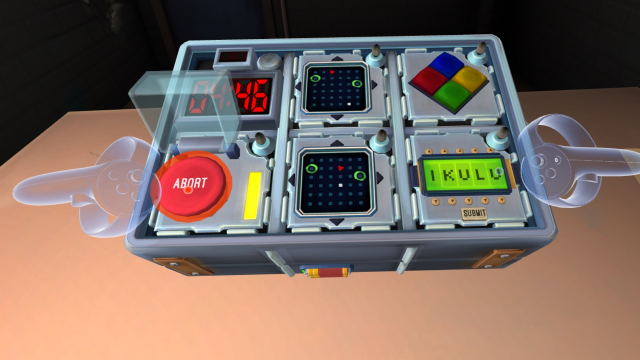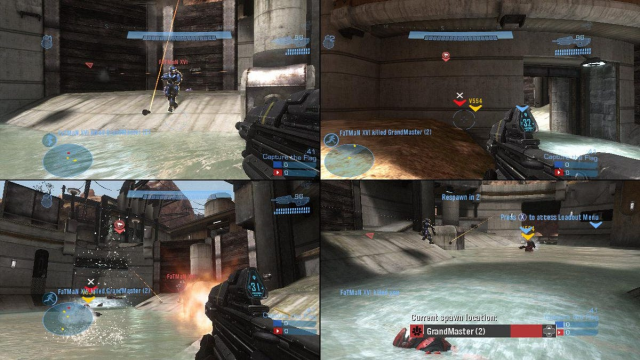If you’re a gamer, you’ve probably heard about this VR game. I think it’s one of the more innovative works for VR, so please keep reading and (hopefully) nobody explodes.
Introduction
Keep Talking and Nobody Explodes (subsequently shortened as Keep Talking) is a 2015 multiplayer puzzle game initially developed for Virtual Reality (VR) systems. The game is played with at least one “Defuser”, who is given a virtual bomb to defuse, and one or more players as “Experts”, who has to communicate instructions to the Defuser for them to successfully defuse the bomb.
How this works with VR: the Defuser wears the head-mounted display (HMD), and using the controls, they manipulate the bomb within the game. Examples of interactions include cutting wires, pressing buttons, and flipping switches. Meanwhile, the Experts read off a manual to the Defuser, giving instructions on how to defuse the bomb. Of course, the bomb is different (procedurally generated) each time, which means the players need to communicate to each other, as neither can see each other’s bomb/manual.

Check out the game here.
Why is it engaging?
Firstly, the Defuser is given a lot of pressure in trying to Defuse the bomb within a given amount of time. This goal-oriented behaviour coupled with time pressure and a wealth of interaction types, gives the player strong feelings of satisfaction (if things go well), control, and pressure (if things don’t go well) that increase engagement and hopefully, presence, because the virtual elements command the player’s full attention. Otherwise, they explode (and if done right, the fear of explosion feels very real).
Fidelity
The game is relatively low-fidelity; the visuals are kept simple and distinct for easier visual recognition of patterns, and the controls are not 100% high-fidelity either. You won’t have to actually exert “pressure” (push) to press a button, nor make any cutting motion to cut a wire. However, if you’re using VR controllers, the bomb’s representation in 3D space is quite accurate, such that it feels like you’re handling a real object, and moving/rotating the bomb following the movement of your hands.
This strikes a fine balance between control and frustration. The user is kept in control with regard to rotating the bomb and visually inspecting it, as that is a required interaction to gather information, but there are no unnecessary interactions that create only frustration, that detract from the main point of the game.
Innovative take on VR
Yet, the point of the game is strangely to not be fully present within the virtual environment.
Why? Because while the game is projecting stimuli onto the player, they still have to remain aware of external stimuli — in this case, audio stimuli outside of the VR environment, which are the defusal instructions given by the other players.
This game’s best features are in what it lacks. The creators of the game were inspired by the fact that users had to queue to use VR HMD for demos. Wanting to involve those not using the HMD, they created this game, which creatively turned the lack of HMD into a feature.
Moreover, the use of HMD not only transports the user into the virtual environment, it also removes the user from the actual environment. The creators realised that the HMD not only create stimuli, but also remove stimuli from the actual world, in this case, visual stimuli.
Removing Stimuli
If you’re a gamer from an earlier generation, you may be familiar with split-screen gameplay. One challenge throughout this era of gameplay was in keeping information from others. If you were competing with other players, it was a common tactic to look at their portion on the screen for a tactical advantage, like knowing their location.

Using VR technology, Keep Talking used the lack of real-world visual stimuli as a feature. The lack of information from the external world naturally provides immersion for the Defuser, but also perfectly serves as a game mechanism. Perhaps the use of VR HMD may provide a new angle on having multiple screens and differing streams of information in gameplay.
Possible Improvements
As it stands, the game is very modifiable. You may find several custom-made modules (puzzles on the bomb) or modifications to make the game more challenging, such as having the player drive a bus while defusing the bomb. I imagine if there’s a change that could be made, someone could have already made the modification.
The player base seems to adore challenge, so although I mentioned the game does not have high-fidelity interactions above, perhaps it would be a good optional challenge for the game.
In any case, it has been nearly 10 years since the publishing of this game, and VR technology has definitely become more accessible for the general public due to increase in support, production, and popular usage (such as with the advent of the Metaverse).
The original problem that the game sought to address (Lack of VR HMD sets) can now be set aside to pave the road for further innovations, involving more HMDs. Perhaps, it could now offer two-way gameplay, such as two players both performing the role of Defuser AND Expert, each given incomplete information and needing to help each other progress to defuse their own bomb. A similar concept has been done in this puzzle game, We Were Here, in which clues to solve to one player’s puzzle is found in another player’s world, and vice versa.
Altogether, Keep Talking creates a novel experience for co-operative work by encompassing VR’s features (and lack thereof). Apart from recreational activities, it’s been used in work interviews by this company for a quick gauge of how potential hires work with each other, showcasing the use of VR demos beyond pure entertainment. Do give the game a try if you haven’t already, and try not to explode!
